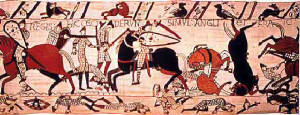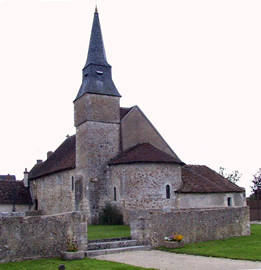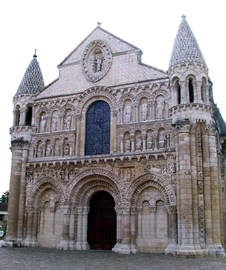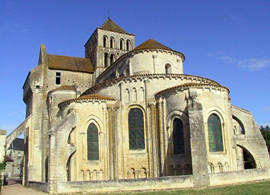|

EARLY MIDDLE AGES
The disintegrating Roman Empire began re-emerging even
as it was falling apart. In what we think of as Western Europe--Britain, the Iberian Peninsula, France, Germany, Austria,
Italy--the formerly Roman world was in the hands of barbarians, but they were barbarians who had real respect for Rome. Many
were Christians, though not necessarily Roman Catholic Christians.
In the East--Greece, Asia Minor and the general Eastern
Mediterranean world--the Roman Empire did not fall at all, and had long been transformed into a Greek speaking Roman Empire
centered at Constantinople. We call it the Byzantine Empire; they simply called it the Roman Empire. We will discuss
them further at a later time, but they preserved much of the literature, law, and ceremony of Ancient Greece and Rome. There
was not a clear break between Eastern and Western Christianity until perhaps the 1200s--1n 1204 Catholic Crusaders would attack
and sack Constantinople which did not make them any friendlier, but there were theological and political issues, not to mention
issues of world view. In the West, the pope came to be a political power in his own right. He controlled land in central Italy,
could depose emperors, princes and kings--but c ouldn't always make it stick--He had his own base of power separate from the
political rulers of the age.
In the East, the Patriarch of the Orthodox Church tended to be a creature of the Emperor, lacked any independent
power base, and supported imperial policy. The Patriarch of Constantinople was the Patriarch as long as the Byzantine Empire
held the world together, but as their world began to fall apart, other patriarchates emerged identified with specific nationalities--Greece,
and Russia became the most important, surpassing older patriarchates in Jerusalem and Antioch.
The other world was also identified by religion--the
world of Islam which too emerged from the Roman-Greek world of religion
and culture, of Aristotle and Jesus. It was also unique, for Arabia was a far away world to the west, and Mohammed's interpretation
of God while it rested on a Judeo-Christian, Hellenistic base, was quite remarkable.
The West The cities were in decline, especially in the
West. Cities depend on trade, on transportation and economic complexity to assert their importance. But in the 400s, they
simply became magnets for invading armies to attack and sack. With the city populations declining, there was much less profitability
in the large estates of the late Roman world. Owners of these large latifundia tended to settle their slaves on small family
farms so they could pay rent--usually in kind, money was becoming less important in the economy than simply being able to
eat.
The free farmers who had once made up the Roman Legions
were much less important in their military roles. The success of mounted troops against foot soldiers meant that armies of
the middle ages would be dominated by horse soldiers who could afford the expense of going to war. The small, independent
farmers, able to exploit technological innovations in agriculture were no longer expected to take months off to fight. He
was, however, increasingly expected to pay for his protection, again in the form of produce. There was a clear distinction
between independent peasant farmers and serfs--people tied to the land--but one wonders if the distinction were not in the
psyche and not in the actual work performed. It is not clear how many people were serfs and how many were free peasants--peasants
seem to have outnumbered serfs.
When the empire as a political unit fell, nothing immediately
emerged to take its place. The Kingdoms of Franks and other kingdoms were much more informal political units than we might
imagine. A king was whoever could act like one and be recognized by his fellows as one, and Germanic tribes tended to elect
their kings and to bind them to respect the ancient customs of the tribe. Thus the basic political and economic unit was the
most local. For much of Northern Europe and England, it was the Manor, made up of 50 to 250 people, a thousand acres or only
a few hundred.
Whereas ancient Europe had been a world of commerce
and interdependence--producing grain in Sicily and Egypt, wine and olives in Italy and Greece, the world of the manor, beginning
about 500 AD was a world of self-sufficiency. The manor would include forests and fields where the lord would hunt boar and
deer, and where the peasants and serfs would range their livestock. It would have commons--open fields where cattle could
be grazed--numbers regulated by custom and tradition to prevent overgrazing. In addition, each peasant or serf--and it is
difficult to draw a line sometimes--would have several strips of land in various parts of the manor. These might be passed
on to children, or they might be exchanged on occasion. The manor would have a mill and a wine press and craftspeople to weave
and mend and do all the things a rural economy needs, which is not a great deal.
The Lord of the manor and his family would live perhaps
in a rude building in the middle of a wood and earthen stockade called a donjon. He provided justice for the members of the
community, hearing cases about stolen pigs and who got whom pregnant out of wedlock, punishing wrongdoers and, at least in
the ideal, defending with his sword the peace of the community.

WEAPONS AND ARMOR
European warriors of the early Middle Ages used both
indigenous forms of military equipment and arms and armor derived from late Roman types. One of the most widely used types
of helmet was the Spangenhelm. Body armor was usually either a short-sleeved mail shirt (byrnie), made up of interlocking
iron rings, or a garment of overlapping scales of iron, bronze, or horn. Shields were oval or round and made of light, tough
wood covered with leather. Metallic mountings lined the rims. A hole in the center of each shield was bridged by a hand grip
inside and a shield boss outside. Weapons were the spear, sword, ax, and the bow and arrow.
At the height of the Middle
Ages, Saint Anselm (ca. 1033–1109) listed the equipment of a knight: his war horse (which by the thirteenth century
was protected by mail and fabric), bridle, saddle, spurs, hauberk (a long-sleeved mail shirt, sometimes with a hood, or coif),
helmet, shield, lance, and sword. Toward the end of the twelfth century, a new flat-topped type of helmet with side plates,
which hid the face of a knight, became popular. To distinguish friend from foe, the knight's triangular shield was painted
with identifying symbols. By 1200, mail for the legs, called chausses, was commonly worn by mounted warriors. Later, boiled
leather or steel pieces protected the knees (kneecops), while small squares of the same hard materials covered the vulnerable
shoulder joints (ailettes).
By the fourteenth century, the improved crossbow was able to pierce shields and mail armor.
To counter this, knights first wore a poncho-like coat with small rectangular plates riveted to it, while articulated plate
armor was developed for the legs, arms, and hands. The small, square, convex shield of the time (the targe) was eventually
relegated to use in tournaments, since improved body armor made it unnecessary. A new form of helmet joined the all-encompassing
great helm and the wide-brimmed chapel-de-fer (war hat). This was the more streamlined, close-fitting bascinet, with a curtain
of mail (camail) from chin to shoulders, which frequently had a movable visor. By the late 1300s, solid breastplates first
appeared to protect the chest as part of the short, tight-fitting coat of plates called a brigandine, while smaller plates
covered the abdomen, hips, and back.
Within a few years, by about 1420, full head-to-toe plate armor was in use, completing the image of the knight in shining
armor.

THE BARBARIC PERIOD- CLOTHING
The few roads that still existed were in a bad state, bridges were
scarce, and brigands were common. For this reason during the Dark Ages, which lasted until about 1000 A.D., populations were
tightly bound to the land surrounding the feudal lord's castle. People moved about only when there were festivals in other
cities. These were the only occasions on which people could buy or look at different goods and have a chance to sell their
own food or objects and fabrics made for sale. Fear controlled people’s lives and induced them to ask for protection
from powerful warriors who had constructed well-defended castles, or from monasteries, which did not have soldiers but did
have thick walls to hide behind. Life was hard, and , people thought little of clothing. Clothes were often made at home and
were often rough and shapeless. Trousers, tunics and shawls were used to keep away the cold. The shawls were made of wool
or fur and put over the shoulder. Most Europeans were dressed like today’s Benedictine monks, except for men’s
trousers. Shoes were leather wrapped around the foot. Colors were plain; they were shades of gray, brown, dark blue and red.
Conical hats were commonly worn.
This was a pyramidal society because the classes of people were in
a shape of a pyramid.. with the kings and queens at the top of the pyramid (and were few in number) down to the peasants (who
were many in number). In the middle were feudal lords, clerics, and others, such as vassals.


QUESTIONS ABOUT THE MIDDLE AGES:
1. What is the situation of Medieval Europe between 450-75-AD?
2. Why is Christianity considered the salvation of the western world at this time?
3. What caused the decline of the western cities at this time?
4. What is the importance of a MANOR to the people?
5. What type of armor was used at this time?
6. Why is life so hard at this time?
7. What is the meaning of pyramidal society?
8. Why is the movement of people very limited during the Middle Ages?
9. What is feudalism?
10. Why did people build high and thick walls during this period?
GOTHIC PERIOD
A history of the Gothic period of Art and Architecture
Gothic Art is concerned
with the painting, sculpture, architecture, and music characteristic of the second of two great international eras that flourished
in western and central Europe during the Middle Ages

Gothic art
evolved from Romanesque art and lasted from the mid-12th century to as late as the end of the 16th century in some areas.
The term Gothic was coined by classicizing Italian writers of the Renaissance, who attributed the invention (and what to them
was the non-classical ugliness) of medieval architecture to the barbarian Gothic tribes that had destroyed the Roman Empire
and its classical culture in the 5th century Ad. The term retained its derogatory overtones until the 19th century, at which
time a positive critical revaluation of Gothic architecture took place. Although modern scholars have long realized that Gothic
art has nothing in truth to do with the Goths, the term Gothic remains a standard one in the study of art history.
Architecture
was the most important and original art form during the Gothic period. The principal structural characteristics of Gothic
architecture arose out of medieval masons' efforts to solve the problems associated with supporting heavy masonry ceiling
vaults over wide spans. The problem was that the heavy stonework of the traditional arched barrel vault and the groin vault
exerted a tremendous downward and outward pressure that tended to push the walls upon which the vault rested outward, thus
collapsing them. A building's vertical supporting walls thus had to be made extremely thick and heavy in order to contain
the barrel vault's outward thrust.
Medieval masons
solved this difficult problem about 1120 with a number of brilliant innovations. First and foremost they developed a ribbed
vault, in which arching and intersecting stone ribs support a vaulted ceiling surface that is composed of mere thin stone
panels. This greatly reduced the weight (and thus the outward thrust) of the ceiling vault, and since the vault's weight was
now carried at discrete points (the ribs) rather than along a continuous wall edge, separate widely spaced vertical piers
to support the ribs could replace the continuous thick walls. The round arches of the barrel vault were replaced by pointed
(Gothic) arches which distributed thrust in more directions downward from the topmost point of the arch.
Since the combination
of ribs and piers relieved the intervening vertical wall spaces of their supportive function, these walls could be built thinner
and could even be opened up with large windows or other glazing. A crucial point was that the outward thrust of the ribbed
ceiling vaults was carried across the outside walls of the nave, first to an attached outer buttress and then to a freestanding
pier by means of a half arch known as a flying buttress. The flying buttress leaned against the upper exterior of the nave
(thus counteracting the vault's outward thrust), crossed over the low side aisles of the nave, and terminated in the freestanding
buttress pier, which ultimately absorbed the ceiling vault's thrust.
These elements
enabled Gothic masons to build much larger and taller buildings than their Romanesque predecessors and to give their structures
more complicated ground plans. The skillful use of flying buttresses made it possible to build extremely tall, thin-walled
buildings whose interior structural system of columnar piers and ribs reinforced an impression of soaring verticality.
Throughout this period, the central corridor of Europe running northwest from Lombardy to England,
between Cologne and Paris, retains an exceptional importance. Much of the significant art--especially architecture--was produced
within this geographic area, because it appears to have been an extraordinarily wealthy area, with enough funds to attract
good artists and to pay for expensive materials and buildings. Paris --for much
of this period the home of a powerful and artistically enlightened court--played an especially important role in the history
of Gothic art.
Gothic architecture and art 
Section: The Nature of the Gothic
Related: European Art
The essential character of the Gothic period,
particularly at the outset, was the predominance of architecture; all the other arts were determined by it. The character
of the Gothic visual aesthetic was one of immense vitality; it was spikily linear and restlessly active. Informed by the scholasticism
and mysticism of the Middle Ages, it reflected the exalted religious intensity, the pathos, and the self-intoxication with
logical formalism that were the essence of the medieval. Gothic style was the dominant structural and aesthetic mode in Europe
for a period of up to 400 years.
QUESTIONS ABOUT GOTHIC ARCHITECTURE AND ART
1. What is the origin of the word Gothic?
2. What is the problem that masons encounter in building heavy masonry?
3. How is the problem solved?
4. Why are flying buttresses important in making tall and heavy buildings?
5. Why is Gothic architecture abundant from Cologne to Paris?
6. What impressions do Gothic architecture give to people?
|

